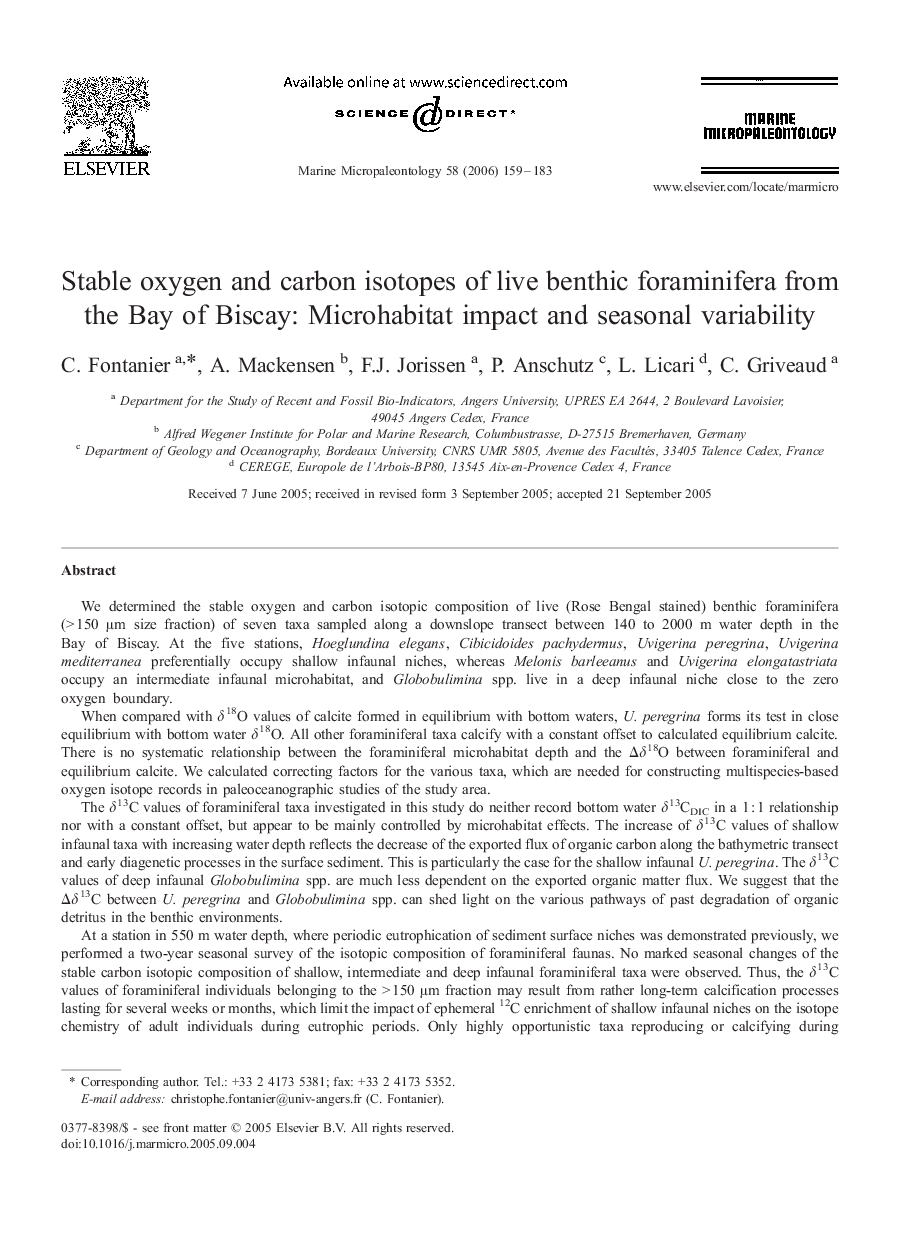| کد مقاله | کد نشریه | سال انتشار | مقاله انگلیسی | نسخه تمام متن |
|---|---|---|---|---|
| 4749574 | 1360467 | 2006 | 25 صفحه PDF | دانلود رایگان |

We determined the stable oxygen and carbon isotopic composition of live (Rose Bengal stained) benthic foraminifera (> 150 μm size fraction) of seven taxa sampled along a downslope transect between 140 to 2000 m water depth in the Bay of Biscay. At the five stations, Hoeglundina elegans, Cibicidoides pachydermus, Uvigerina peregrina, Uvigerina mediterranea preferentially occupy shallow infaunal niches, whereas Melonis barleeanus and Uvigerina elongatastriata occupy an intermediate infaunal microhabitat, and Globobulimina spp. live in a deep infaunal niche close to the zero oxygen boundary.When compared with δ18O values of calcite formed in equilibrium with bottom waters, U. peregrina forms its test in close equilibrium with bottom water δ18O. All other foraminiferal taxa calcify with a constant offset to calculated equilibrium calcite. There is no systematic relationship between the foraminiferal microhabitat depth and the Δδ18O between foraminiferal and equilibrium calcite. We calculated correcting factors for the various taxa, which are needed for constructing multispecies-based oxygen isotope records in paleoceanographic studies of the study area.The δ13C values of foraminiferal taxa investigated in this study do neither record bottom water δ13CDIC in a 1 : 1 relationship nor with a constant offset, but appear to be mainly controlled by microhabitat effects. The increase of δ13C values of shallow infaunal taxa with increasing water depth reflects the decrease of the exported flux of organic carbon along the bathymetric transect and early diagenetic processes in the surface sediment. This is particularly the case for the shallow infaunal U. peregrina. The δ13C values of deep infaunal Globobulimina spp. are much less dependent on the exported organic matter flux. We suggest that the Δδ13C between U. peregrina and Globobulimina spp. can shed light on the various pathways of past degradation of organic detritus in the benthic environments.At a station in 550 m water depth, where periodic eutrophication of sediment surface niches was demonstrated previously, we performed a two-year seasonal survey of the isotopic composition of foraminiferal faunas. No marked seasonal changes of the stable carbon isotopic composition of shallow, intermediate and deep infaunal foraminiferal taxa were observed. Thus, the δ13C values of foraminiferal individuals belonging to the > 150 μm fraction may result from rather long-term calcification processes lasting for several weeks or months, which limit the impact of ephemeral 12C enrichment of shallow infaunal niches on the isotope chemistry of adult individuals during eutrophic periods. Only highly opportunistic taxa reproducing or calcifying during phytoplankton bloom periods and the subsequent deposits of phytoplankton remains in the benthic environment may exhibit a particularly low δ13C, indicative of such short productive periods.
Journal: Marine Micropaleontology - Volume 58, Issue 3, 30 January 2006, Pages 159–183